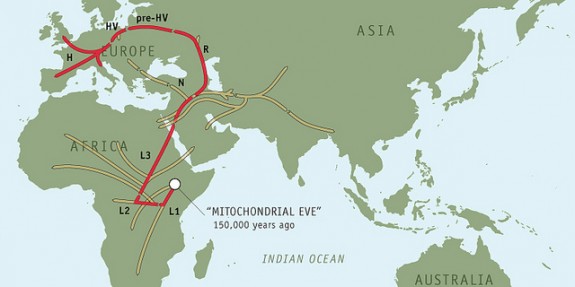One Man’s Seven-Year March Along Ancient Migration Routes
This past Sunday, journalist Paul Salopek began his walk from Ethiopia to Patagonia

By tracking mitochondrial DNA, you can retrace the path followed by your ancestors. Photo: Mirthe Valentijn
Starting this Sunday, two-time Pulitzer prize winning journalist Paul Salopek will walk the path of our ancestors in a seven-year journey around the world. Called “Out of Eden: A Walk Through Time,” the journey will take Salopek along the migratory routes of early humans, from Ethiopia to Patagonia, on the southern tip of South America.
Seeking to understand the march of the early humans from evolution to global dominance, researchers have turned to DNA analyses, particularly of the genetic material found in mitochondria, as a way to trace lineages and, in turn, migratory routes. Guy Gugliotta wrote in 2008 for Smithsonian Magazine:
n broad outline, today’s scientists believe that from their beginnings in Africa, the modern humans went first to Asia between 80,000 and 60,000 years ago. By 45,000 years ago, or possibly earlier, they had settled Indonesia, Papua New Guinea and Australia. The moderns entered Europe around 40,000 years ago, probably via two routes: from Turkey along the Danube corridor into eastern Europe, and along the Mediterranean coast. By 35,000 years ago, they were firmly established in most of the Old World. The Neanderthals, forced into mountain strongholds in Croatia, the Iberian Peninsula, the Crimea and elsewhere, would become extinct 25,000 years ago. Finally, around 15,000 years ago, humans crossed from Asia to North America and from there to South America.
Unlike actual early humans, Salopek probably won’t be hunting down meals with a pointed stick or get chased around by lions. Nor will he face the possibility of conflict with other hominid species. The point of this journey isn’t to report on history, though, Salopek told NPR:
“I don’t want this to be misperceived as a journey about the past,” he says. “I’m using the past as a road map. I’m using what scientists are telling us are the closest approximations of how we dispersed out of the mother continent, Africa, about 50,000 to 70,000 years ago.”…
“It’s very much about the present day. It’s about how we’ve changed the world, and how the world is being radically altered in our view by such things as the Internet.”
The migration path Salopek will walk originally took tens of thousands of years for early humans to traverse, with the forerunners of modern human societies splintering off in multiple branches along the way. Salopek’s walk will be shorter. But the quest should provide an interesting lens on the multiple and varied societies that have come to inhabit this little Earth of ours. According to the Knight Foundation, one of the sponsors of the project,
Salopek’s goal is to cover the major global stories of our time —from climate change to conflict, from mass migration to cultural survival — by walking alongside the people who live them: cattle nomads, artists, traders, villagers and scientists. Beginning at the birthplace of humanity in Ethiopia and ending in Patagonia, Argentina, Salopek aims to see how this “slow journalism” reveals hidden pathways that link all of our stories.
That might sound a bit vague, but it’s a purposeful vagueness. “Serendipity is a big part of this project,” Salopek told PBS Newshour.
More from Smithsonian.com:
The Great Human Migration
How to Retrace Early Human Migrations
Green Sahara May Have Provided Route out of Africa for Early Humans
/https://tf-cmsv2-smithsonianmag-media.s3.amazonaws.com/accounts/headshot/smartnews-colin-schultz-240.jpg)
/https://tf-cmsv2-smithsonianmag-media.s3.amazonaws.com/accounts/headshot/smartnews-colin-schultz-240.jpg)